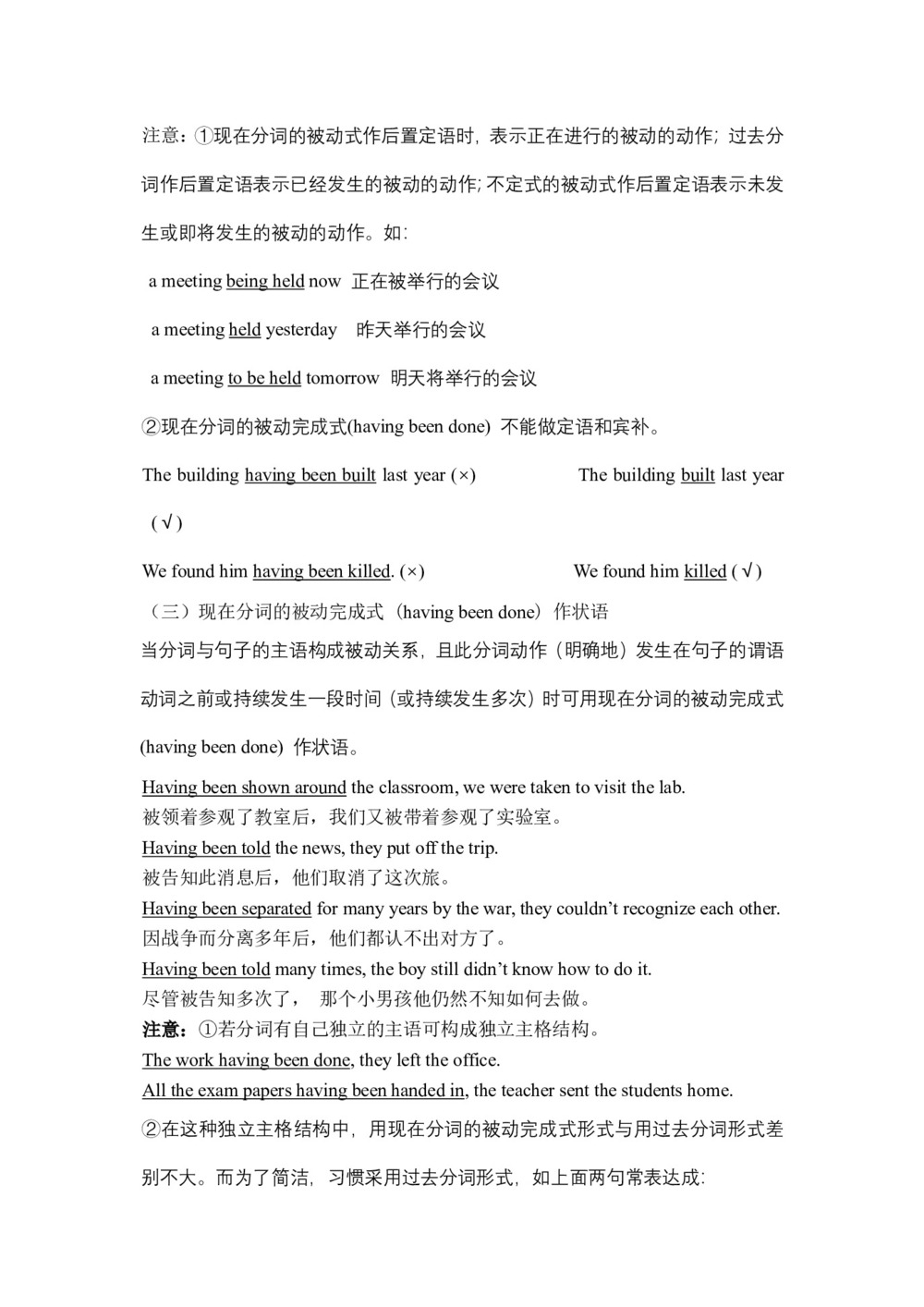
注意:①现在分词的被动式作后置定语时,表示正在进行的被动的动作;过去分词作后置定语表示已经发生的被动的动作;不定式的被动式作后置定语表示未发生或即将发生的被动的动作。如:
a meeting being held now 正在被举行的会议
a meeting held yesterday 昨天举行的会议
a meeting to be held tomorrow 明天将举行的会议
②现在分词的被动完成式(having been done) 不能做定语和宾补。
The building having been built last year (×) The building built last year (√)
We found him having been killed. (×) We found him killed (√)
(三)现在分词的被动完成式 (having been done) 作状语
当分词与句子的主语构成被动关系,且此分词动作(明确地)发生在句子的谓语动词之前或持续发生一段时间(或持续发生多次)时可用现在分词的被动完成式(having been done) 作状语。
Having been shown around the classroom, we were taken to visit the lab.
被领着参观了教室后,我们又被带着参观了实验室。
Having been told the news, they put off the trip.
被告知此消息后,他们取消了这次旅。
Having been separated for many years by the war, they couldn't recognize each other.
因战争而分离多年后,他们都认不出对方了。
Having been told many times, the boy still didn't know how to do it.
尽管被告知多次了, 那个小男孩他仍然不知如何去做。
注意:①若分词有自己独立的主语可构成独立主格结构。
The work having been done, they left the office.
All the exam papers having been handed in, the teacher sent the students home.
②在这种独立主格结构中,用现在分词的被动完成式形式与用过去分词形式差别不大。而为了简洁,习惯采用过去分词形式,如上面两句常表达成:
The work done, they left the office.
All the exam papers handed in, the teacher sent the students home.
注意:过去分词作状语与现在分词的被动完成式的区别:
二者作状语时,都表示与句子的主语构成被动关系,区别不大,可以互换。但是在这种情况下,为了简洁,还是习惯采用过去分词形式作状语。
Asked (= Having been asked) to work overtime, I missed a wonderful film.由于昨晚被要求加班,我错过了一场精彩的电影。
Polluted (=Having been polluted) seriously, the water in the river was not safe to drink.但是如果强调分词动作发生在句子的谓语动词之前或强调分词动作持续发生多次发(或持续一段时间)还是习惯采用现在分词的被动完成式(having been done) 作状语,但终归区别还是不大。
Having been told many times, he still repeated the same mistakes. 尽管被告诉了多次,他
-
相关教案下载
- 12019学年度人教版选修七Unit Three Under The Sea Period4 Grammar教案(4页word版)
- 22019学年度人教版选修七Unit 3Under the sea Period4 Grammar 学案设计(6页word版)
- 32019学年度人教版选修七Unit3Under the sea Period 4 Grammar教案设计(3页word版)
- 42019学年度人教版选修七Unit3Under the sea Period4 Grammar教案设计(2页word版)
- 52019学年度人教版选修七Unit 3 Under the sea Period3 Grammar教案设计(3页word版)
- 62019学年度人教版选修七Unit 3 Under the sea Period3 Grammar教案设计(6页word版)
- 72018学年度人教版选修7Unit3Under the sea Period4Grammar -ing形式 课件(61张)
- 82019学年度人教版选修7 Unit 3Under the sea Period4 Grammar教案(2页word版)
- 92019学年度人教版选修八Unit 3 Period4Grammar学案(1页word版)